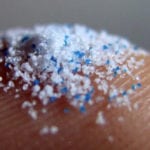 Mysteries
Mysteries  Mysteries
Mysteries  History
History 10 Surprising Stories About the Texas Rangers
 Humans
Humans 10 Philosophers Who Were Driven Mad by Their Own Theories
 Miscellaneous
Miscellaneous 10 Video-Game-Worthy Weapons and Armors from History
 Weird Stuff
Weird Stuff 10 Psychics Who Accurately Predicted Wartime Events
 The Arts
The Arts 10 Pieces of Art Inspired by a Broken Heart
 Health
Health 10 Science Fiction-Sounding New Medical Treatments
 History
History 10 Surprising Facts About the Father of Submarine Warfare
 Space
Space Ten Astonishing New Insights into Alien Worlds
 Weird Stuff
Weird Stuff 10 Bizarre Summer Solstice Rituals Still Practiced Today
 Mysteries
Mysteries Top 10 Haunting Facts About the Ghost Ship MV Alta
 History
History 10 Surprising Stories About the Texas Rangers
 Humans
Humans 10 Philosophers Who Were Driven Mad by Their Own Theories
Who's Behind Listverse?

Jamie Frater
Head Editor
Jamie founded Listverse due to an insatiable desire to share fascinating, obscure, and bizarre facts. He has been a guest speaker on numerous national radio and television stations and is a five time published author.
More About Us Miscellaneous
Miscellaneous 10 Video-Game-Worthy Weapons and Armors from History
 Weird Stuff
Weird Stuff 10 Psychics Who Accurately Predicted Wartime Events
 The Arts
The Arts 10 Pieces of Art Inspired by a Broken Heart
 Health
Health 10 Science Fiction-Sounding New Medical Treatments
 History
History 10 Surprising Facts About the Father of Submarine Warfare
 Space
Space Ten Astonishing New Insights into Alien Worlds
 Weird Stuff
Weird Stuff 10 Bizarre Summer Solstice Rituals Still Practiced Today
Top 10 Bizarre And Scary Jobs For Commercial Divers
Underwater diving isn’t just a recreational activity, it’s an important trade with many industrial applications. Commercial divers are fearless professionals who work in dangerous environments. Most divers specialize in one type of underwater work, with the big bucks going to those who aren’t afraid to take on significant health and safety risks. Here’s a list of some of the most fascinating (and often disgusting) jobs that commercial divers perform.
10 Underwater Welding
The idea of welding metals together underwater seems almost impossible, but it’s one of the more useful trades a commercial diver can pick up. The technique for joining metals together underwater dates to the 1930s and is most often used to repair submerged structures like bridges, ships, and pipelines.
There are two basic types of underwater welding: dry and wet. Dry welding, the more common version, requires a hyperbaric chamber which creates a seal around the welding area. Water is pumped out of the chamber by hoses, then replaced with a gaseous mixture including helium and oxygen. Offshore jobs like oil rigs often employ “habitat welding,” where the gas-filled chamber is large enough to fit one or more divers. Helium and oxygen are pumped in while toxic welding gases are pumped out to create a dry, breathable workspace.
Wet welding is considered much riskier because salt water is a very effective conductor of electricity. Wet welders often use a technique called shielded metal arc welding, which protects them from being electrocuted by generating a layer of gaseous bubbles around the welding area. Even with proper safety procedures, both wet and dry welders face hazards like electrocution, explosions, and drowning. Not a job for the faint of lung.
9 Sewer Diving
Sewer systems for major cities have a lot of moving parts. Hundreds of pipes and pumps are required to flush away the daily waste of humanity, and you better believe they get clogged up with all manner of unmentionables. That’s when you call the sewer diver. Julio Cu Camara has been plumbing the depths of Mexico City’s sewers for almost four decades to maintain the elaborate drainage system that keeps the city clean. Working in a hermetically sealed three-centimeter-thick dive suit, Cu takes weekly plunges into the black water to perform routine maintenance of motor parts.
Julio can repair pumps in a day that would take two weeks to fix otherwise. Oh, and did we mention he does it completely blind? “Black water” isn’t just an expression. The sewers of Mexico City are so full of human and chemical waste that no light has been able to illuminate the foul depths. Cu is getting up in years, so he’s been training a replacement to take over his important job when he retires. Along with the unimaginable stench, the next sewer diver of Mexico City will have to get used to finding the occasional dead horse or pig floating in the sewers without wondering “who flushed that?”
8 Aqueduct Repair
New York City’s water supply comes from reservoirs in the Hudson Valley and Catskill Mountains, which connect to the metropolis by massive tunnels like the 85-mile Delaware Aqueduct. The city noticed leaks in the aqueduct in the late 1980s and eventually hired a Seattle diving firm to investigate. In February of 2008, a team of divers was dispatched to the bowels of the aqueduct, where they lived for two weeks in a sealed and pressurized chamber complete with sleeping quarters, toilets, and even a Nerf basketball hoop. The chamber itself was had to be pressurized with 97% helium and 3% oxygen so the divers could easily transition into the high-pressure underwater shaft without risking decompression sickness (a.k.a. “the bends”).
Divers working 24-hour shifts were lowered 700 feet into the shaft to inspect the structure and take measurements for repair equipment. Later that year, the city sent divers into the aqueduct again for nearly a month to fix the valves at the bottom of the shaft. The divers who lived in the saturated chambers had to be gradually weaned off helium over the course of a week to reacclimate them to surface air. Diver Chris Hackworthy said one of the biggest challenges was communicating in the helium environment, which made everyone sound like Alvin and the Chipmunks. Helium also dulls tastebuds, so the crew ate a lot of Tabasco and jalapeños during their underground deployment. Better hope that bathroom had some fans in it, since they probably didn’t pack any Febreze.
7 Nuclear Diving
Nuclear power plants need a lot of water to keep running, both to generate electricity and to manage hazardous waste. When their water infrastructure needs maintenance, plant managers turn to nuclear divers. A lot of what divers do for nuclear plants is “mudwork,” low-risk tasks like cleaning intake pipes in the lakes that supply the plant’s water. These pipes can get clogged with debris from the lake, including schools of fish who mistake the plant’s heat for warm spawning water. Cleaning fish guts out of giant pipes might be gross, but it doesn’t put divers at risk of radiation exposure. However, they do closely monitor their radiation doses when performing riskier tasks like repairing the underwater carts that move spent fuel rods from reactors to the pools where they are stored.
During longer dives in high-radiation environments, divers sometimes find their dosimeter creeping up beyond the acceptable maximum. When this happens, the plant managers must decide whether they’re going to send someone else in or grant an extension allowing the diver to exceed the legal exposure limit. As most nuclear divers will tell you, the big worry isn’t one-time exposures but small doses over long periods, which can have unpredictable effects on human health. As one spouse of a diver said in a Popular Science article: “Who wants a glowing husband?”
6 Discovering Lost Civilizations
No one has yet located the fabled city of Atlantis, but underwater divers have turned up some incredible archaeological finds. Most people would think of shipwrecks as the main target of underwater archaeology, but that’s just one of many types of sites excavated by divers. Coastlines are always changing, and some areas that were once dry thousands of years ago are now underwater. These submerged sites include Neolithic villages like Atlit-Yam in Israel and more recent seaside settlements like the colonial Jamaican town of Port Royal. In 2020, a group of archaeologists surveyed the area off the coast of Murujuga in northwestern Australia and found 269 stone artifacts with the help of scuba divers. Radiocarbon dating showed that these specimens were between 7,000 and 8,500 years old. Most appeared to be tools for scraping and cutting, though one is believed to be a grindstone used to crush seeds into bread flour. This site was the first one over 5,000 years old to be discovered in the tropics, proving that stone tools can survive on warmer seafloors despite the threats of algae and natural disasters. Underwater archaeology projects show us that bits of the past can be found in every nook and cranny of our planet.
5 Finding Drugs
People hide drugs in a lot of crazy places, but most don’t have the gumption to keep their stash in the ocean. In 2020, a group of volunteer divers surveying an artificial reef off Florida’s Treasure Coast came across a square package floating in the water. When they opened it, they found a kilogram of uncut cocaine, which they turned over to the Coast Guard. This isn’t the first time someone has found drugs off the Treasure Coast. In fact, locals have a nickname for the floating packages: “square groupers.” They are believed to be the product of drug dealers tossing their wares into the ocean when they’re in danger of being caught. An even larger underwater cache of coke was found by the Greek coast guard in April of 2021. Following a DEA tip, coast guard divers found 46.7 kilograms (about 103 pounds) of cocaine in a waterproof bag hidden behind a grate in the hull of a cargo ship arriving from Brazil. Twenty-three crew members were arrested for the drug trafficking attempt. No word on whether local fish started swimming faster.
4 Cleaning Oil Spills
The British Petroleum oil spill in the Gulf of Mexico was one of the worst ocean contaminations in American history. Along with commercial fishermen and residents of the Gulf Coast, some of the most severely affected victims were the divers called in to clean up the spill. Despite the large amounts of carcinogenic crude oil floating in the ocean, commercial divers dispatched for this job were assured by BP’s health and safety specialists that they didn’t need extra protective gear. Cleanup crews worked up to 20 hours a day in contaminated waters, and some divers started getting sick before the job was even over. The crude oil itself was one source of contamination, but it’s also likely the dispersants used by the divers to clean it up exposed them to hazardous chemicals. This brand of dispersant has been banned for years in the United Kingdom due to its negative health effects. Since the spill, nearly all the divers have experienced health problems and at least two have committed suicide as a result. A group of around 700 commercial divers started a class action suit against BP in 2010 which has yet to be resolved.
3 Exploring Icebergs
You might have heard of cave diving, but how about diving in a floating ice cave? That’s what professional cave diver Jill Heinerth and her team did in 2019, marking the first ever dive into the crack of an iceberg. During the descent, Heinerth and her diving companion were pelted by falling isopods, a type of cold-water crustacean which she described as “horror story material.” Things got even more spooky when they attempted to leave and found their entrance blocked up with massive chunks of ice that had fallen off the iceberg. The two divers eventually made a hole in the barrier big enough to swim back through, but the terrors didn’t end there.
On the next dive, a strong current started pulling the divers into the iceberg, almost like it was trying to suck them into its freezing belly. Rather than fight the current, they let it take them away from the exit hole and towards another light source that looked like an alternate way out. When Heinerth surfaced, she found their boat was nowhere in sight, having been pulled away by the same current that sucked them into the iceberg. Eventually the crew in the boat found the divers and they cheated death once again.
On the third dive, Heinerth took two other divers with her into the iceberg. After descending into the crevasse, she realized almost immediately that the current was too strong and gestured to her companions to leave. Only once again, they couldn’t leave. After dragging themselves against the current towards the exit, they found themselves unable to get back up the crevasse due to water pouring in. Heinerth came up with the plan of scaling the crevasse wall using tiny holes in the glacier as handholds. After climbing 130 vertical feet of ice, the solemn diver had only one thing to say to her crew: “the cave tried to keep us today.”
2 Sewage Diving
If the story about the sewer divers was too much for you, go ahead and skip this one.
Now that everyone with weak stomachs has scrolled past, those of you left are probably wondering why this list item exists if we already covered sewer diving. That’s because there’s an even worse job than diving in sewer water: diving in liquefied, undiluted poop. Rather than sewer systems, professionals like Austrian diver Gregor Ulrich work in wastewater treatment plants, where they are sent into digestion towers filled with sewage sludge.
At facilities like the Winterthur waste treatment plant, towers are designed to process the sludge using aerobic bacteria fed by compressed air blowers and then moved to larger anaerobic towers where it generates methane gas. This creates a highly flammable environment for the divers who routinely maintain these towers and gas levels must be closely monitored to prevent explosion. Not to mention the fact that the sludge is kept around 37 degrees Celsius (98.6 Fahrenheit) for maximum ick factor. Ulrich says it feels a lot like wallowing in warm mud, and he prefers it to diving in cold water. His bosses must be happy he feels that way, since having divers saves the plant a huge amount of money compared to having to shut down operations and empty the tower out every time it needs to be cleaned.
1 Searching for Lost Cheese
In a 2005 story that could be titled À la recherche du fromage perdu (In Search Of Lost Cheese), a French-Canadian cheesemaker called in professional divers to find 800 kg (about 1763 pounds) of cheese that he had dropped in a lake. Luc Boivin of La Fromagerie Boivin in the Saguenay region of Quebec left the dairy stash underwater on purpose because he thought aging it in a lake would impart a unique flavor. Apparently, he didn’t secure it well enough, because a year later there was no cheese to be found. A team of professional divers combed the Saguenay Fjord using high-tech tracking equipment, but eventually the search had to be called off. Boivin feared if he kept paying for search teams, he would lose more money than the 50,000 Canadian dollars the cheese was worth.
The cheesemaker had been inspired to employ this unorthodox aging technique after a fisherman found a block of his cheese in the lake which Boivin said was the best he’d ever tasted. Maybe it was so good the divers took it and didn’t tell anyone. And hey, they deserve a treat. You’ve seen some of the stuff they deal with at work.








